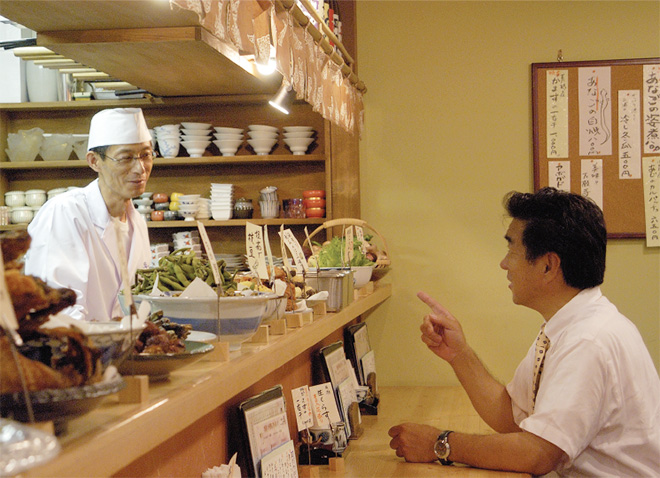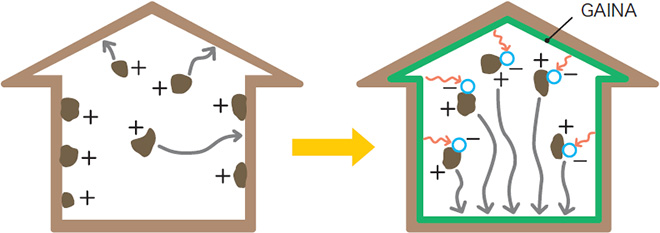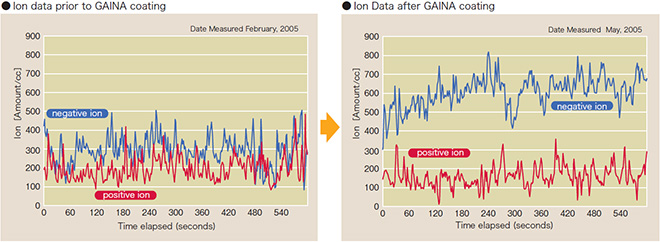Less cigarette and alcohol odors make for a more pleasant restaurant!

※Painted area: interior walls – about 55m2 (59 sq. ft.)
“Food and drinks taste better when the air is clean. I wanted to create a restaurant where the customer would feel refreshed”
says the owner of a Japanese restaurant located near Fujisawa Station in Kanagawa Prefecture. The owner found that providing a coat of GAINA to the interior of his new shop created a homey atmosphere. What surprised him most was,
“the lack of alcohol and cigarette odors lingering from the previous day. I almost forget to ventilate the room!”
GAINA makes cleaning a breeze as it greatly reduces the amount of unwanted smells and dust that stick to walls, a common issue with restaurants. This restaurateur could barely hide his pleasure at the unexpected yet very welcome effects GAINA provided.
Greatly improved air quality creates an atmosphere of living in the woods!

One family located in Fukushima Prefecture gave their new home a coat of GAINA to ensure it didn’t become dusty, like their previous home. After living in their new home for a while, they were happy to find that,
“it feels like we are living in the woods.”
Another GAINA fan located in the north part of Tokyo was worried about odors in his condo. After renovating his condo and adding a coat of GAINA, he was pleased with the results.
“After applying GAINA, my home smells great and is so comfortable.”
The owner of a dental office in Fuji City, Shizuoka Prefecture, used GAINA to improve the air in his offices and help patients feel more relaxed. He has since received many compliments from patients commenting on the comfortable atmosphere.
Prevents odor and contaminants from floating in air and adhering to walls.

Dust, dirt, pollen and other common airborne contaminants gain positive electric energy as they float in the air, which prompts electrostatic adhesion to walls and ceilings. GAINA’s electrostatic propensity of 0.0 prevents dust, dirt, and pollen from adhering to surfaces, while its ionized moisture fuses with airborne dirt and particles, reducing the amount of impurities floating in the room environment.
GAINA’s Effect on Creating Air that Makes You Feel Good
By Dr. Teruo Iwasaki, Doctor of Education (Preventative Medicine)
The special ceramic beads featured in GAINA emit infrared radiation when heat or light energy is received, due to the ceramic’s extreme infrared radiation emission capacity. This capacity activates water molecules in the room air, creating negative air ions. The negative ionized moisture in the air is able to purify dust, dirt, and pollen present in the air. Our bodies also consume this negative ionized moisture in the air when we breathe. This effect is created when the interior of a room is coated with GAINA, generating the ideal quality of air for human consumption. In other words, GAINA creates “ air that makes you feel good,” thus establishing a comfortable living environment.
When considering air quality, it is important to evaluate the balance between positive and negative ions. It is often said that positive ions are bad and negative ions are good, but the truth is, it is essential to have a good balance between the positive and negative ions in order to benefit from the negative ones. This has been verified through air quality control measures used inside spaceships. The ideal balance of the two kinds of ions will restrain the growth of toxic substances and germs through oxidation and restoration, resulting in excellent air quality.
Ion balance measurements taken in a room that has been applied with a coat of GAINA showed that the room, previously containing significant amounts of positive ion and dust particles, presented favorable counts of negative ions and significantly less dust and dirt, bringing the atmosphere much closer to the ideal level. I find the effect of GAINA achieves in improving room air quality and making comfortable living conditions highly valuable and hope many people benefit from GAINA’s ability to enhance our lifestyles.

Ph.D. in Education (Hokkaido University) Born in Matsue City, Shimane Prefecture. Proposed, planned and administered “Cure-house”as a type of balneotherapy, or hot spring therapy, and “Forest Bathing” as a forest therapy, while working in a complementary function for the Ministry of Welfare, the Ministry of Agriculture,Forestry and Fisheries, and the Ministry of the Environment. He also measured distribution of negative air ions all over Japan in forests cultivated by Centenarians, and is currently creating a map the results. He is also focuses his attention on the deoxidizing sterilization of negative air ions and is involved in measures to prevent Legionella pneumophila and sick-house syndrome.
